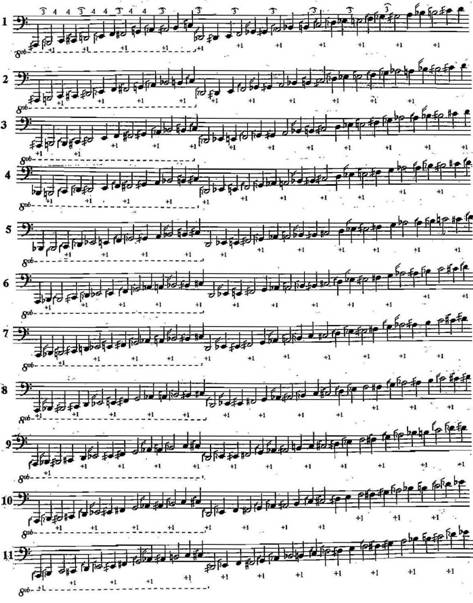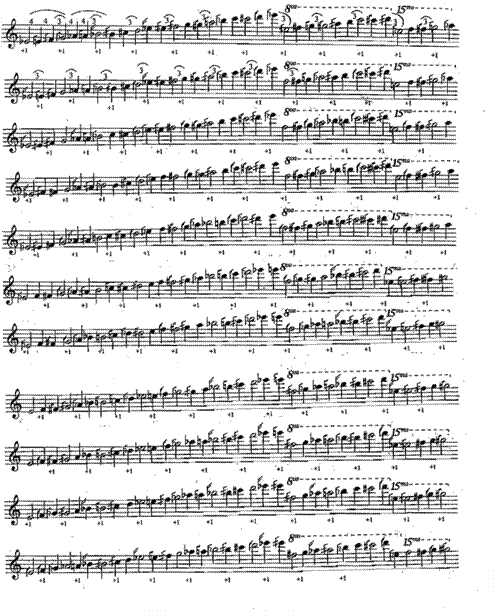Poème du Délire
Bruce
Mather
In
1979 I discussed with Ivan Wyschnegradsky two concert projects, one for the Fragments Symphoniques I, II, III for four pianos
in quarter tones which I realized in January 1980 as a memorial concert (as Wyschnegradsky
had passed away in September. 1979) and the first performance of his three
works in sixths of tones for three pianos, Prélude
et Fugue op 30 (1945), Composition
op.46 No. 1 (1961) and Dialogue
àTrois op.51 (1974). For the concert on April 21st, 1983
two Canadian colleagues wrote new pieces, Aspects
of Jack Behrens and Le
Parcours duJour of John Winiarz and I produced Poème du Délire. The
following year the three Wyschnegradsky works plus those of Behrens and myself
appeared on a vinyl disc of McGill University Records. Among Wyschnegradsky's
manuscripts without opus numbers I discovered years later the Deux Mèditations also for
three pianos in sixth of tones. I conducted the first performance of the work
on May fifteenth, 1996 with pianists Pierrette LePage, Louis Philippe Pelletier
and Paul Helmer.
As
I had used for my quarter tone works the non-octaviant spaces in "régime
onze" (i.e. cycles repeating at a major seventh), I opted for his
analogous system for sixths of tones. In this system (see Appendix A) the
interval of the major seventh (33 sixths of tones) is divided into three equal
intervals of 11 sixths of tones (one sixth less than a major third). These
notes are in white. Each interval of eleven sixths of tones is subdivided into
three intervals of four, four and three sixths of tones (or 2/3 tone, 2/3 tone,
semitone). For notation in sixths of tones I use only four new signs:
![]() (a sixth tone higher)
(a sixth tone higher)
![]() (two sixths tone higher
(two sixths tone higher
![]() (a sixth tone lower),
(a sixth tone lower),
![]() (two
sixth tones lower).
(two
sixth tones lower).
It should be explained that in Poème du Délire (and in
the works of Wyschnegradsky in sixths of tones) Piano I is tuned a sixth of a
tone sharp, Piano II at normal pitch and Piano III a sixth of a tone flat:

Figure 1: Tuning of Three Pianos in Sixth of Tones
From one
position to the next, in the eleven positions one of the three notes rises a
sixth of a tone. From position 1 to position 2 it is the 'white' note, from
position 2 to 3 it is the first black note and from position 3 to 4 it
is the second black note. The result is that, while in position 1 the division
of each interval of 11 sixths of tones is 4,4,3, in position 2 it is 3,4,4 and
in position 3 it is 4,3,4. In order to obtain smaller melodic intervals (1 or 2
sixths of tones) I combine two positions such as 1 and 6 (Example 2). This
produces many intervals of thirds of tones and some sixths of tones.

Example 1:
Combination of Positions 1 and 6

Example 2:
Melodic Structure of Section B

Example 3: Harmonic Structure of Section B
Formally
Poème du Délire
is characterized by the presence of six different elements or textures, most of
which return in a different context, duration or contour. Here are the six
elements:

Here
is the large-scale formal plan in four sections, determined by the return of
the elements.

Figure 2: Large-Scale
Formal Plan of Poème du
Délire
It
is interesting to observe the role of each element in the large-scale
structure. "A" starts the work as a long slow monody. It ends the
second and third sections as fast monodies. In the final section it overlaps
with elements "B" and "C". In section I "B"
starts with a higher melody joined soon in dialogue by a lower strand. In
section II it appears, much shorter, with a low melody in fast groups of 2 or 3
notes. In section III the fast groups appear in a dialogue, high and low. In
the final section the fast groups are transformed into element "A".
Element "C" appears in section I and then in section IV, accompanying
the monody "A" and then alone, ending the work. Element "D"
appears in sections I, II, III in progressively shorter versions. Element
"E" appears in sections I, II, III in the same position with durations
of 11, 8 and 8 bars. It begins the final section with a large development of 48
bars. Element "F" appears only once, at the end of section I.
Detailed
Analysis
Section
1 A
As
shown in Example 2, the eleven phrases of A use the combine positions 1+6, 3+8,
4+10, 7+1 and 9+3. The scheme below shows the melodic shapes, the note values
used for each phrase, and the intervals used (in sixths of tones). Note the
ritardandos from phrases 4 to 6 and 7 to 11 (see Figure 3).
Section
B Harmonic structure (see Example 3)
In
each of the 11 positions a white note is followed by 2 black notes. The
intervals (in sixths of tones) are 4,4,3 or 3,4,4 or 4,3,4, always a total of
11 (A sixth tone small than a major third). Chords built from the white notes
carry the letter "a", those built from the first black note
"b", and those built from the second black note "c".

Figure 3: Section B Melodic/Intervallic and Shapes and Rhythmic Values
![]()
Of the
ten chords most have seven notes but three (numbers 1,7,10) have 8 notes. The
top notes of the ten chords are relatively static (from to
![]() ) but the ranges vary from just over
two octaves (chord 3) to over 3 octaves (chord 7). Three intervals are used
11/6, 22/6 and 44/6. As can be seen below only two chords (numbers 4 and 9)
have the same spacing:
) but the ranges vary from just over
two octaves (chord 3) to over 3 octaves (chord 7). Three intervals are used
11/6, 22/6 and 44/6. As can be seen below only two chords (numbers 4 and 9)
have the same spacing:

Figure 4: Section
B Chord Spacings
![]()
Divided
among the three pianos, each piano has two or three notes of each chord (except
for piano I in chord number 8 with only one note). The notes of each
piano are presented in rhythmic ostinatos of 4, 5 or 6 values per half giving,
respectively, eighths, quintuplets of eighths and triplets of eighths. The
patterns of the triplets can be described as 7+(3), i.e. 7 notes in triplets
then 3 in silence etc.
![]() The quintuplet
pattern can be described as 5+(1), i.e. 5 notes in quintuplets plus one in
silence
etc.
The quintuplet
pattern can be described as 5+(1), i.e. 5 notes in quintuplets plus one in
silence
etc.
The
pattern in eighths is less regular as in Piano III p.2 (3+(2), 4+(1), etc.) As
shown below the distribution of the ostinatos between the three pianos changes
constantly:
![]()
Figure 5:
Distribution of Ostinatos Between Piano in Section B

Example 4: Melodic
Strands of Section B

Example 5:
End of Section B

Example 6:
Chord Vocabulary of Chorale:
Section
B Melody
As
shown in Example 4 a high melody (from m.2) is joined by a low melody (m.8).
The two strands then converge. In order to create a rhythmic independence from
the accompanying ostinatos the attacks of the melody are on the second or
fourth sixteenth of the beat. In the first three phrases (over harmonic
structures 4b, 5a, 6b) of 3, 5, and 5 notes, the actual perceived rhythm is h
h h \
q . h q q . h \ q q q h h
.The
dialogue between the two strands starting at m. 8 can be represented thus:

Figure 6a: Representation
of the Dialogue Between Two Strands at M. 8
The high
line descends while the low line rises. The actual perceived rhythm for this
passage is:

Figure 6b: Perceived
Rhythm at M. 8
The
values over chord ![]() are more complex with accelerations 6 , 4, 3,
3, 2 x s
. At chord
are more complex with accelerations 6 , 4, 3,
3, 2 x s
. At chord ![]() the two strands have the same melodic curve
the two strands have the same melodic curve ![]() but
the durations of the first two notes are different. Each line creates an
accelerando - ritardando pattern:
but
the durations of the first two notes are different. Each line creates an
accelerando - ritardando pattern:

Figure 7: Rhythmic Contour in
High and Low Strands
The
phrase over chord ![]() is identical. Over the final chord
is identical. Over the final chord ![]() the eighth-note pulsation returns with a
dialogue similar to that at m. 8:
the eighth-note pulsation returns with a
dialogue similar to that at m. 8:
![]()
Figure 8: Dialogue
of Eight-Note Pulsation in Final Chord of Section B
Example
6 shows the end of the section where the accompanying ostinatos stop, leaving
the convergence of the two parts into a five-note ostinato in x s, then a trill
and a final rising line with ritardando, all in position ![]() .
.

Example 7: Chordal
Development of Chorale
Chorale
In
general the top notes of the chords of the seven phrases of this chorale
(phrases of 4,4,4,4,3,3,2 chords) describe a slowly descending curve. The
chords increase in density (3,5,8,13 notes, see Example 7). Durations in
quarters are marked below each chord. Example 7 shows the vocabulary of chords
of 3,5,8 and13 notes (all in position 1). The letters describe the range of the
chords C (1 ¼ octaves), D (1 ¾ octaves) E (2 ½ octave), F 2 ¾ octaves), G (4
octaves), B (less than an octave).
D
This
element is characterized by a melody in sixteenths or triplet eighths
accompanied by chord in quarter, halves or dotted halves. Example 8 shows, in
increasing range, the five-chord formations used: I, II, III, IV, V. Example 9
shows the actual chords and positions.

Example 8: Increasing Range in Section D

Example 9:
Harmonic Structure in D
Figure 9
presents the various rhythmic patterns of the melody and the chords which are
articulated in 2,3 or 4 attacks. There are patterns of 5, 6,7 and 9 beats for
the 12 phrase which contain successively 6,6,7,5,7,5,9,9,5,5,6,6 beats.

Figure 9:
5-, 6-, and 9-Beat Rhythmic Patterns Between Melody and Chords in D
Example 10 shows the first melodic note of
each phrase and its melodic direction (descending, rising descending and then
rising, static). Example 11 shows the first two bars in sixth of tone notation.

Example 10:
Contour Structure in Section D

Example 11: Opening
Measures of Section D
Section
E
The
first section of trill motives marked "leger, envolé: (q = 150) lasts 11
bars. In fact the successive 5-note broken chords of the accompaniment last
6,6,6,10,9,7,7,6,6 beats as shown in Example 12. The five-note chords are
constructed with intervals of 11 and 22 sixths of tones in three different
formats:

Figure 10: Interval
Formats for Construction of 5-Note Chords in E
Example
12 also gives the first note of each trill or chromatic scale motive which
lasts a quarter, half or dotted-half. The motives pass from one piano to
another in the order III, I, II, I, III, II, III, I, II etc. At the beginning
the successive notes of departure are relatively conjunct (intervals of three
and four sixths of tones) but the line becomes more and more mobile. At the end
one has intervals of 11 and 22 sixths of tones.

Example 12:
Opening Succession of 5-Note Chords
in Section E

Example 13:
Harmonic Structure of "Broken Chords" Section
Broken
Chords p. 5 m.5
Following
the first appearance of the trill motives this section acts as a parenthesis.
As shown in Example 13, the seven chords are of 34, 21, 21, 13, 13 8 different
notes following the numbers of the Fibonacci series with a progressively
reduced range and dynamic level. The successive positions used are 3(+8),
6(+11), 9(+3), 1(+6),4, 7(+1),10.
Since
there are only 36 different notes per octave in the scale in sixths of tones
and since I wished to avoid octaves, I was obliged to used the resources of two
positions in many cases (3+8, 6+11, 9+3 etc.) Example 13 shows that the chords
are constructed first with the intervals of 22 and 11 sixth of tones with
smaller intervals in the upper register.
The
chords are broken in various ways. Chords 1,2, and 4 have a fast arpeggio
followed by a solid chord (pp) in the
upper register. Chord 6 is a solid chord (pp). Chord 3 is expressed in triplets
(q
=80), three notes at a time. Chord seven is expressed in 3+2+3 notes and chord
five as single notes in triplet (q =120).
"F"
- Tremolandos pg. 8
Already
at the end of page three (at the end of B) we have a preview of the tremolando.
Exclusively in the high register, this passage is in three parts. The first
consists of tremolando clusters of six notes (two in each piano) rising through
an octave followed by a descending monody.
Example
13 shows the notes from positions 10 and 4 and the actual notes played by each
piano, 5 notes for piano I, eight for piano III and seven for piano III.
Example 15 gives the descending monody in sixth of tones notation and a
"diatonic version" allowing us to see more clearly the melodic curve
in descending groups of 3,2,2,4,2,3 notes.

Example 14: Distribution
of Notes from
Positions 10 and 4 Among the Three Pianos in Section F

Example 15: Descending Monody in Section F
The
second part starts with six note clusters like the first part but this develops
into rapid ostinatos of five and six notes for each piano ending with a rapid
broken chord of 21 notes. It uses positions 2+7. The third part is a
counterpart to the first but with descending clusters and a rising monody. It
uses positions 5+10.
Section
Two
As
already mentioned this section recapitulates some of the elements of section I
with various modifications, the most extremes being A which is now a fast
rather than a slow melody and is placed at the end rather than at the beginning
of the section.
B'
Marked
"mystérieux, menaçant" this passage is only half the length of B in
section I. The seven slowly rising chords of 9 or 10 notes use positions 5a,
6b, 7a, 8a, 8b, 10a, 11a (see Example 10). Instead of broken chord ostinatos
exclusively of 4,5, or 6 notes per half there ar two new arrangements, one
slower (3,4,5) and one faster (5,6,7) as follows:
![]()
The
last chord is articulated ff
with repeated three-note chords in each piano. The melodic element, exclusively
in the low register, is reduced to two or three note "calls in x s (in chords 2 - 6)
moving in third or sixth tones. In Example 16 these are indicated in 'black'
notes.
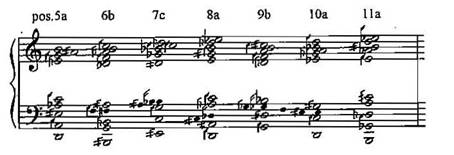
Example 16: Harmonic Structure in B'
D
p. 10
This passage lasts only seven bars (as
opposed to 12 bars for D in section I). The melodic line is quite static but
descends gradually (except for the last bar which rises to prepare for E). The bar
lengths are 7,5,7,5,6,6,6 q s. Example 17 shows the seven harmonic structures,
at first with a large span (three octaves) then converging to less than two
octaves. The Roman numerals refer to the same chord construction used for D in
section I.

Example 17: Harmonic/Registral
Development of D pg.10
E end of p.
10
The
general curve of this passage is descending. Example 18 shows that the seven
successive structures (built with intervals of 11 and 22 sixth of tones) widens
and then contracts. Example 18 also shows the first note of each trill pattern.
They follow the following descending and rising patterns:
![]()
A'
p.11 m.7
This
rising monody (see Example 19) is developed rhythmically by the filtering of
one six-beat pattern:
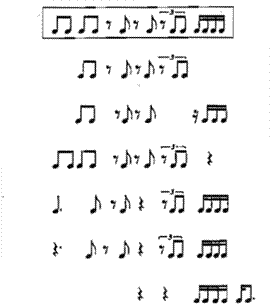
Figure 11: Rhythmic Filtering of
6-Beat Patterning in A'
Section
III
The
section has the same elements in the same order as section II, - B' and D being
shorter, A' longer and E the same length.
B'
p. 12
The
four slowly-rising chord structures have 8,9,9,9 notes in positions 1a, 2b, 3c,
4a (see Example 20). The ostinatos create an accelerando as follows:
![]()
Figure 11: Resultant Accelerando From Combination of Chords Structures
in B'

Example 18:
Harmonic/Registral Development of E on pg.10

Example 19: Rising Monody in A' pg.11

Example 20:
Rising Chord Structure of B' on pg. 12
The new
element is the dialogue between low and high two- and three-note
"calls". This can be shown as follows:
![]()
Figure 12: Registral "Dialogue" in B'
In
Example 20 they are shown in 'black' notes.
![]()
![]() D p. 12 m. 10
D p. 12 m. 10
The
melody of this passage starts higher than D of section II and descends
constantly from to . The four chords of eight notes use
positions 4,5,6,7 and decrease in range (see Example 21). Note that the bass
notes descend with small intervals (semitones and 2/3 tones) and the top notes
of the chords with large intervals. The durations of the four chords increase:
5,5,6,9 q s.

Example 21: Registral/Harmonic Development of D on pg. 12
E
p.13 m.3
Contrary
to section II the design here is ascending. The eight basic chords (Example 22)
have durations of 6,4,6,4,6,6,7,7 q s. The melody is in
four rising phrases and chord in two expanding formation (1-4, 5-8) using
positions 8a, 10b, 1c, 3a, 5b, 7a, 9bm 11c.
A'
This
fast monody lasts thirteen bars (as opposed to seven bars before A' of section
II, see Example 23). As in A' in Section it develops through a rhythmic
filtering of the same six-beat pattern (see Figure 13). Sometimes only 2,3,4 or
5 beats of the original pattern are used as a basis for the filtering.

Example 22: Harmonic/Melodic
Development of E on Pg. 13

Example 23:
Monody of A' on pg. 13
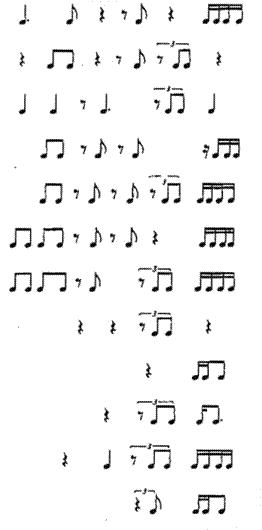
Figure 13: Filtering of 6-Beat Pattern in A'
Section
IV
E
p.14 m.9
Example
24 gives the first note of each trill pattern for the six parts of this
passage:

Example 24: Trill Contour of E on pg. 14:
I Each of the four phrases has a descending
and rising curve. The four phrases have 5,5,5,7 notes, each lasting two or
three beats.
II The five phrase
create an almost continuous descent with the following rhythmic pattern: h
h h \ h q q q : \
h h h h h h.
III This part features an alternation of
registers with mostly three-note phrases
![]()
There is an effect of rallentando with only q at the beginning and only h
at the end.
IV The five rising
phrases of 5,5,7,7,5 notes feature only h at the beginning but
introduce more and more q.
V This continuously rising passage is almost
an inversion of II
![]() VI The four phrases
of 5,5,6,3 notes feature mainly large intervals (22 sixths of tones). The
five-note phrase have the same design
: .
VI The four phrases
of 5,5,6,3 notes feature mainly large intervals (22 sixths of tones). The
five-note phrase have the same design
: .
The
third phrase rises in intervals of eleven sixth of tones.
Example
25 shows the harmonic vocabulary of the 5-note accompanying chords with
increasing range (a,b,c,d,e) and variations within each range
(c1,c2,d1,d2,d3,d4).Example 26 gives the accompanying chords for the six parts:

Example 25:
Harmonic Vocabulary in E on Pg. 14

Example 26: Accompanying Chords in E on Pg. 14

Example 27: Coda
Pg.18
Coda
p.18 m.2
In
the final passage the elements B, A and C gradually melt one into the other. As
shown in Example 27 there are five chords of eight notes in converging
registers. These five chord are displayed in ostinatos thus:
![]()
Figure 14:
Ostenato Organization in Coda
After
the third and fourth chords there ar pauses. At this point the two and three-note
"calls" are transformed into a melodic line (element A). Starting at
p. 10 m.6 the element C starts with chord of 5,5,8,13,21,13 and 21 notes.
Between these chords the melody dissolves in motives of 2,3,2 and 3 notes. The
twenty-one-note chord is presented first in two parts (15 high notes then 6 low
notes) and secondly in three parts rising (3+6+12).
Poème du Délire is dedicated to the memory of Alexander
Scriabine (1871-1915) and his disciple Ivan Wyschnegradsky (1893-1979).
Although it stylistically very different from the works of Scriabin, there is
nevertheless a certain influence of the spirit of "Poème de l'Extase"
and "Poème du Feu". In any case both Scriabin and Wyschnegradsky are
composers whose music I treasure deeply.
APPENDIX
A: "Régime
Onze"
